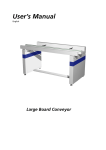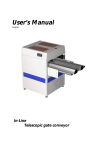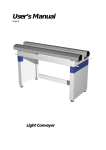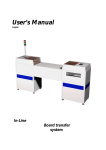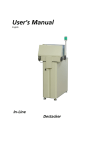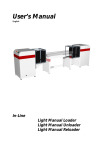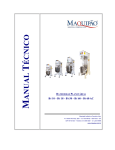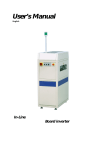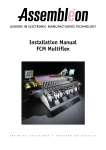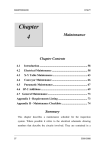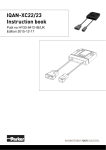Download User`s Manual
Transcript
User’s Manual English T3 / T4 Conveyor User´s Manual This manual is intended for the inline device specified on the previous page. The manual contains information to assist the operator to start and operate the device properly, and to maintain it. Hardware and software mentioned in this document are subjected to continuous development and improvement. Consequently, there may be minor discrepancies between the information in the document and the performance and design of the hardware and software. Specifications, dimensions and other statements mentioned in this document are subject to change without prior notice. Conventions In this manual angle brackets <> are used to indicate certain button or selector switch names. Example: <Start> stands for the START button. This manual comprises the following conveyor models • • • • • • 500mm 700mm 1000mm 1500mm 2000mm 2500mm Manufacturer and its suppliers shall not be liable for any damages related to the software or hardware, or for any other damages whatsoever caused of the use of or inability to use any manufacturer product. This is applicable even if manufacturer has been advised of the damage risk. Under any circumstances, manufacturer’s entire liability shall be limited to replace such defective software or hardware which was originally purchased from manufacturer. Printed in Sweden. mb702_061121u.doc/ 2006-12-11 1 User´s Manual Contents 1. SAFETY ................................................................................................................... 4 Warning sign .................................................................................................................. 5 Warnings......................................................................................................................... 5 2. INSTALLATION ...................................................................................................... 6 Site preparation............................................................................................................... 6 Ambient conditions ........................................................................................................ 6 Technical data................................................................................................................. 6 Installation...................................................................................................................... 7 3. PRODUCT DESCRIPTION....................................................................................... 8 Conveyor main parts ...................................................................................................... 8 Overview ......................................................................................................................... 9 General function............................................................................................................. 9 Control system.............................................................................................................. 11 4. OPERATION SETUP .............................................................................................. 15 5. MAINTENANCE.................................................................................................... 16 Weekly .......................................................................................................................... 16 Monthly ........................................................................................................................ 17 Yearly ............................................................................................................................ 17 Lubricant specifications ................................................................................................ 18 OKS 270 ........................................................................................................................ 18 6. SERVICE ............................................................................................................... 19 Exchange of conveyor belt drive motor ....................................................................... 19 Exchange of conveyor belt rollers ................................................................................ 21 Exchange of conveyor belt ........................................................................................... 22 Setting of conveyor parallelism .................................................................................... 22 mb702_061121u.doc/ 2006-12-11 2 User´s Manual Figures Figure 1-1 Electric shock .................................................................................................... 5 Figure 1-2 Attention........................................................................................................... 5 Figure 3-1 Main parts ......................................................................................................... 8 Figure 3-2 Power switch ................................................................................................... 11 Figure 3-3 Hand unit buttons .......................................................................................... 11 Figure 3-4 Pack-length sensor .......................................................................................... 13 Figure 3-5 Speed control .................................................................................................. 13 Figure 6-2 Cover open...................................................................................................... 19 Figure 6-3 Motor & cables................................................................................................ 20 Figure 6-4 Drive wheel ..................................................................................................... 20 Figure 6-5 Belt roller ........................................................................................................ 21 Figure 6-6 Conveyor parallelism...................................................................................... 22 mb702_061121u.doc/ 2006-12-11 3 User´s Manual 1. Safety Before starting the machine, it is necessary that the operator, foreman and any other personnel involved in the machine operation, maintenance or service understand and obey the following: • Trained personnel must operate the machine only. • Anyone operating this machine must obey all warning signs. • Do not use chemicals or other substances that may have any influence on the operator or other personnel involved in machine operation. • Apart from weekly, monthly and yearly maintenance described in Chapter 5, Maintenance, the machine is to be serviced by authorised personnel only. • All covers and shields must be intact, mounted and closed while the machine is in operation. • Do not disable or disengage any safety switches or sensors. • No hands or fingers are allowed in the vicinity of moving parts of the machine. mb702_061121u.doc/ 2006-12-11 4 User´s Manual Warning sign The warning sign on the machine must be observed as this machine contains electrically live parts. The warning sign on the machine is placed on the cover of the electrical cabinet. The sign must be kept clean and readable. Figure 1-1 Electric shock If the sign is missing, it must be replaced immediately. The sign warns of electric shock. Units on which this sign is placed contain dangerous voltage levels. Power supply must be disconnected before opening the unit. Only authorised service personnel are allowed to operate the machine when the unit is open. This sign is applied as follows. • One sign on the cover of the electrical cabinet. Warnings Attention Throughout the manual, this symbol is used to call your attention to commands that starts machine movements. The symbol refers to the warning signs, which must be obeyed to eliminate the risk of injury. If there are instructions accompanying this symbol, they must be followed. Figure 1-2 Attention mb702_061121u.doc/ 2006-12-11 5 User´s Manual 2. Installation The machine is delivered fixed on a pallet. Site preparation Prior to installing the conveyor. Ensure that there is electric power available on the site, see the requirements below. Check also if the ambient conditions meet the requirements specified below. Ambient conditions The ambient air must be clean. Relative humidity 0 to 35°C 10 to 90 % noncondensing 35 to 60°C 10 to 60 % noncondensing Allowed temperature Operating: 5 to 40°C (41 to 104°F) Storage: -40 to 60°C (-40 to 140°F) Dust and dirt The machine does not require a clean-room environment but the level of dust and dirt must be kept as low as possible. The maintenance intervals are shortened by high temperature and dusty or dirty environment. Technical data Machine Weight: Length: Power supply Voltage: Frequency: mb702_061121u.doc/ 2006-12-11 Depending on actual size. See specification included in the contract. 100-240 VAC 50/60 Hz 6 User´s Manual Lifting information The machine can be lifted with a forklift truck. Put some wooden boards between the forks and the vertical frame parts. Installation The installation must be carried out by authorised service personnel. Placing the unit Ensure that the floor is sturdy. Place the machine on its site. To be able to install, maintain and service the conveyor, there must be a free space of one meter around it, except for other devices and machines included in the conveyor line. Levelling Level the complete line carefully along the conveyor belts. Use a spirit level across and along the conveyor belts when adjusting the feet of the machine. The machine must stay steady on all feet when the adjustment is finished. Joining the units The frameworks of the units to be joined are bolted together with two plates and screws. Mains supply Mains supply is to be connected by an authorised electrician. The transformer is auto adaptable to different primary voltages. (100 to 240 VAC) mb702_061121u.doc/ 2006-12-11 7 User´s Manual 3. Product description This chapter describes the conveyor. The description is divided into the following main sections: • Main parts of the conveyor. • Overview • General function of the conveyor. • Control system. Conveyor main parts C A B E F D G H Figure 3-1 Main parts The following main parts are pointed out in the figure above, by the letters. Main parts A. B. C. D. Safety cover. Fixed rail. (Normally front rail) Moving rail with sensors. Cabinet 1, electrical cabinet with power supply and control electronics. E. Cabinet 2. F. Power switch. G. Smema connector. H. Smema connector mb702_061121u.doc/ 2006-12-11 8 User´s Manual Overview The conveyor (C) consists of a framework, an electrical cabinet and two conveyor assemblies. It is equipped with controls for width adjustment and optional functions such as automatic width adjustment and board train. Also, a board present sensor is positioned at the end of each belt segment. General function Standard conveyor: The conveyor transfers boards from one machine to another. One PCB can be positioned on each belt segment of the C at a time. When the C is ready to receive a PCB from the preceding unit, the C signals ”Ready” on the Smema In connector. Board transfer from the preceding unit to the conveyor starts, when the preceding unit signals ”Board Available” (BA) and the C signals ”Ready” on the Smema In connector at the same time. When a PCB activates the board present sensor on the last conveyor segment, the C signals ”BA” on the Smema Out connector. If the subsequent machine signals ”Ready” while the C signals ”BA” on Smema Out connector, the board is fed out from the conveyor. The C can be used as a manual loading conveyor, if boards are placed anywhere on the conveyor activating a board present sensor. Packing conveyor (Board train): The conveyor transfers boards, one by one, from the preceding machine, and sends a pack (pcb-train) of boards to the subsequent machine. One PCB can be positioned on each belt segment of the C at a time, except on the last conveyor segment where the pack is built. When the C is ready to receive a PCB from the preceding unit, the C signals ”Ready” on the Smema In connector. Board transfer from the preceding unit to the conveyor starts when the preceding unit signals ”Board Available” (BA) and the C signals ”Ready” on the Smema In connector at the same time. When the board has passed the board present sensor on the last but one conveyor segment, the last conveyor segment immediately stops. When the pack of boards on the last conveyor segment reaches the ‘Pack-length sensor’, the pack mb702_061121u.doc/ 2006-12-11 9 User´s Manual of boards is transported to the board present sensor located at the end of the last segment, and the C signals ”BA” on the Smema Out connector. If the subsequent machine signals ”Ready” while the C signals ”BA” on Smema Out connector, the pack of boards is fed out from the conveyor. The C can be used as a manual loading conveyor, if boards are placed anywhere on the conveyor activating a board present sensor. Unpacking conveyor (Board train): The conveyor receives and separates a pack (pcb-train) of boards, and transfers boards, one by one, to the subsequent machine. One PCB can be positioned on each belt segment of the C at a time, except on the first segment where the pack is received. When the C is ready to receive a pack of boards from the preceding machine, the C signals ”Ready” on the Smema In connector. Board transfer from the preceding unit to the conveyor starts when the preceding unit signals ”Board Available” (BA) and the C signals ”Ready” on the Smema In connector at the same time. When a pack is received at the first segment board present sensor, the speed of the first segment is lowered, and separation is achieved between the first and second segment. When a PCB activates the board present sensor located at the end of the last segment, the C signals ”BA” on the Smema Out connector. If the subsequent machine signals ”Ready” while the C signals ”BA” on Smema Out connector, the board is fed out from the conveyor. The C can be used as a manual loading conveyor, if boards are placed anywhere on the conveyor activating a board present sensor. mb702_061121u.doc/ 2006-12-11 10 User´s Manual Control system Power switch Use the Power switch to turn the conveyor off or on. 0: Conveyor off. All electrically controlled movements are stopped and mains supply is disconnected. 1: Conveyor on. (Production mode enabled.) Figure 3-2 Power switch Hand unit, manual width adjustment Use the two upper buttons to manually adjust conveyor width. Press and hold a button to run the width motor and position the moving rail. The movement stops immediately if the control switch is released or the conveyor is turned off. Figure 3-3 Hand unit buttons mb702_061121u.doc/ 2006-12-11 11 User´s Manual Hand unit, automatic width adjustment (option) Use the button marked ‘AUTO’ to turn automatic width adjustment off or on. An LED positioned above the button is lit when the function is ON. OFF: Automatic width adjustment off. Width information sent from previous machine is ignored. Manual width adjustments are enabled. ON: Automatic width adjustment on. Width is adjusted automatically based on width information received from previous machine, or based on width entered in the optional auto width control unit (K-017-0488). The two width adjustment buttons for manual width adjustments are disabled. Automatic width adjustment must always be set to ON when the optional auto width control unit (K-017-0488) is connected to the conveyor. Hand unit, board train, start of line, end of line (option) Use the button marked ‘BOARD TRAIN’ to turn the packing/unpacking function off or on. An LED positioned above the button is lit when the function is ON. OFF: Packing/unpacking function off. The conveyor works as a standard conveyor. ON: Board train, start of line, or end of line function on. The packing conveyor builds a pack (PCBtrain) of boards on the last conveyor segment. The number of boards in the pack is determined by the position of the ‘Pack-length sensor’ and board size. The unpacking conveyor separates a pack of boards from the first to second conveyor segment. The start of line conveyor separates a pack of boards on the last segment and the end of line conveyor builds a pack of boards, starting at the first or second conveyor segment. Hand unit, inspection (option) Use the button marked with an eye to turn inspection off or on. An LED positioned above the button is lit when the function is ON. OFF: Inspection off. No PCBs are stopped for inspection. ON: Inspection on. Each PCB is stopped for inspection. To release the PCB when inspection is done, press the button marked ‘OK’. mb702_061121u.doc/ 2006-12-11 12 User´s Manual Pack-length sensor, packing conveyor The position of the pack-length sensor determines the number of boards allowed in the pack (pcb-train). Loosen the two screws and move the sensor to desired position. Move the sensor towards the end of the conveyor to allow more boards in the pack. Figure 3-4 Pack-length sensor Speed control, standard (option) Speed control is used when it is necessary to adjust conveyor transport speed to match the speed of the preceding or subsequent machine. The speed control module is located on the electrical plate. Turn the adjustment-knob clockwise to increase conveyor speed, or counter-clockwise to decrease. The standard speed control is applicable to the first or last conveyor segment, and is active only during board transfer from a preceding machine, or board transfer to a subsequent machine. The standard speed control does not reduce conveyor speed during segment-to-segment board transfers (internal board transfers). Figure 3-5 Speed control mb702_061121u.doc/ 2006-12-11 13 User´s Manual Speed control, packing conveyor Speed control on the packing conveyor is used for building the pack (pcb-train) on the last conveyor segment. The speed of the last conveyor segment is reduced during segment-to-segment board transfers, allowing boards to be packed without leaving gaps. See the document BoardTrain_051102u for instructions on how to adjust speed. This speed control is applicable only to the last conveyor segment, and is active only during internal board transfers. Speed is not reduced during board transfers from a preceding machine, or to a subsequent machine. Speed control, unpacking conveyor Speed control on the unpacking conveyor is used for separating a pack (pcb-train) of boards between the first and second conveyor segment. The speed of the first conveyor segment is reduced during segment-to-segment board transfers, allowing the pack of boards to be separated into single boards. See the document BoardTrain_051102u for instructions on how to adjust speed. This speed control is applicable only to the first conveyor segment, and is active only during internal board transfers. Speed is not reduced during board transfers from a preceding machine, or to a subsequent machine. mb702_061121u.doc/ 2006-12-11 14 User´s Manual 4. Operation setup 1. Connect smema cables and mains supply cable. 2. Start the conveyor by switching the Power switch to ON position. 3. Set the width of the conveyor; see the section entitled Control system in the preceding chapter. Slide the PCB manually through the whole conveyor to test the width. The PCB should slide smoothly without getting stuck. 4. The conveyor is now ready for production. mb702_061121u.doc/ 2006-12-11 15 User´s Manual 5. Maintenance The maintenance instructions in this chapter comprise weekly, monthly and yearly maintenance for the conveyor. The maintenance is very important for a continuous operation without unintentional stops. Follow the maintenance instructions carefully and keep the conveyor clean. Lubricants Unless others are stated, use the OKS 270 grease. Grease should be applied in small amounts, just to give a thin film. Specifications and part #’s for the lubricants are found in the end of this chapter. Weekly Clean the machine. Keep the conveyor clean all over. Clean all sensors. Wipe off dust and dirt from all sensors using a soft cotton cloth. Clean the photo sensors at the end of each conveyor segment. If the sensors are not clean, the conveyor will not work properly. All sensors are depicted in the document found in the control cabinet at delivery. mb702_061121u.doc/ 2006-12-11 16 User´s Manual Monthly Check the conveyor belt condition. Check the conveyor belt condition and renew the belts if required. Exchange of conveyor belt is described in the chapter entitled Service. Yearly Guide ways for width adjustment. Apply a small amount of lubricant, (OKS 270), to the entire length, and both sides, of the guide ways. Adjust width to both end positions after applying lubricant. mb702_061121u.doc/ 2006-12-11 17 User´s Manual Lubricant specifications This section contains lubricant data for: • OKS 270 grease OKS 270 OKS 270 is the base lubrication grease for the machine. Data Full product name: OKS 270 Type: Grease paste Colour: Whitish Flash point: >210°C Supplier in Sweden TriboTec AB Box 203 S-435 24 Mölnlycke, Sweden Phone: Nat. 031-88 78 80 Int. +46 31 78 80 www.tribotec.se Manufacturer OKS Spezialschmierstoffe GmbH Triebstraße 9 D-80993 München Phone: Nat. 089-14 98 920 Int. +49 89 14 98 920 www.oks-germany.com mb702_061121u.doc/ 2006-12-11 18 User´s Manual 6. Service This chapter contains the following service procedures: • • • • Exchange of conveyor belt drive motor. Exchange of conveyor belt rollers. Exchange of conveyor belt. Conveyor parallelism adjustment. For other repair works, refer to the drawings and information found in the control cabinet at delivery. Exchange of conveyor belt drive motor 1. Disconnect the power supply at the mains plug. 2. Remove the aluminium cover plate by fitting a small screwdriver to the hole near the end of the conveyor. Use the screwdriver to bend the cover out and up. Then push the cover straight forward and lift it off. Figure 6-1 Opening cover Figure 6-2 Cover open mb702_061121u.doc/ 2006-12-11 19 User´s Manual 3. Remove the drive belt from the drive wheel on the motor that is to be exchanged. 4. Remove the two cables from the drive motor, using a soldering iron. Check the markings so you reconnect them correctly. Figure 6-3 Motor & cables 5. Unscrew the four M3 screws that hold the drive motor, and then pull out the drive motor and the belt drive wheel. Remove the straps, which hold the cables to the drive motor. 6. Unscrew the setscrew that holds the belt drive wheel to the drive shaft using a 1mm Allen key. Mount the belt drive wheel on the new drive motor. Figure 6-4 Drive wheel 7. Mount the new drive motor with the M3 screws and solder the cables back. Finally, replace the drive belt. 8. Mount the aluminium cover plate. mb702_061121u.doc/ 2006-12-11 20 User´s Manual Exchange of conveyor belt rollers 1. Turn the conveyor off, using the Power switch. 2. Remove the aluminium cover plate by fitting a small screwdriver to the hole near the end of the conveyor, as shown in Figure 6-1. Use the screwdriver to bend the cover out and up. Then push the cover straight forward and lift it off. 3. Remove the drive belt from the belt roller that is to be exchanged. 4. If the belt roller is located in the first section of the conveyor, then unscrew the M6 nut using a 10mm monkey wrench (BE adjustable spanner) and replace it with the new belt roller but the old M6 nut and washer. If the belt roller is located in the second or later section of the conveyor, then remove the belt on the adjacent driver motor. Unscrew the four screws holding the adjacent driver motor and lift it aside without removing the cables. Then remove the belt roller by unscrewing the M6 nut and replace it with the new belt roller but the old M6 nut and washer, using a 10mm monkey wrench. Mount the driver motor. Figure 6-5 Belt roller 5. Fit the conveyor belt. 6. Mount the aluminium cover. 7. Turn the conveyor on, using the Power switch. mb702_061121u.doc/ 2006-12-11 21 User´s Manual Exchange of conveyor belt 1. Turn the conveyor off, using the Power switch. 2. Remove the conveyor belt by pulling it to the side. 3. Fit the new belt by pushing it in place from the side. 4. Turn the conveyor on, using the Power switch. Setting of conveyor parallelism 1. Turn the conveyor off, using the Power switch. 2. Loosen all four M8 screws that hold the fixed conveyor rail and adjust parallelism by slightly pushing the conveyor profile in desired direction. Figure 6-6 Conveyor parallelism 3. Tighten the screws when parallelism is achieved. 4. Turn the conveyor on, using the Power switch. mb702_061121u.doc/ 2006-12-11 22























